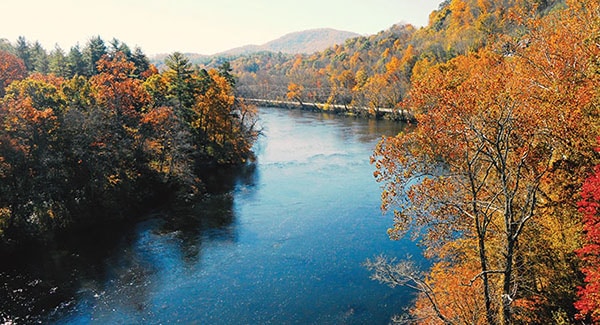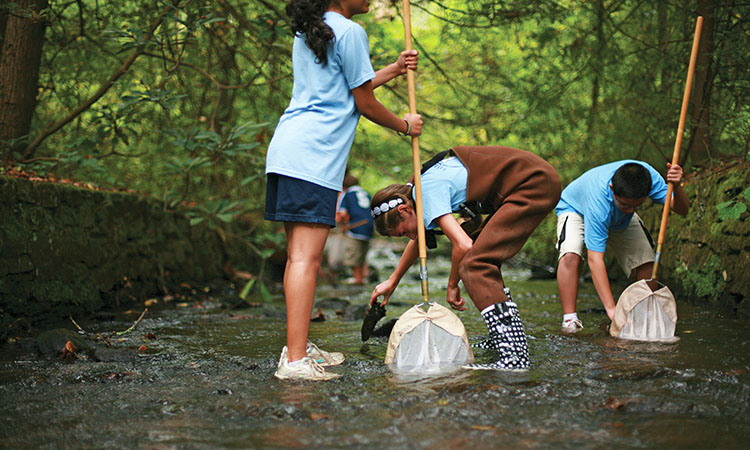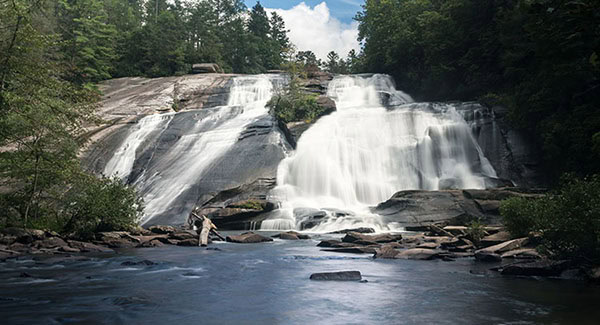
Last Updated on March 23, 2023
The evolution of brachiopods. Giant insects. The entire history of the dinosaurs. The rise of mammals. Possibly four of Earth’s five prehistoric mass extinction events. The mighty French Broad River has seen it all.
Today, we have an overview of the key river system running through Western North Carolina. Here’s everything a beginner needs to know (and more!) about the French Broad River.
Continue reading for:
- French Broad River at a Glance
- French Broad River History & Geography
- French Broad River Climate & Wildlife
- French Broad River Recreation & Pollution
- Seasonal Access & Safety
French Broad River at a Glance
Length: 218 miles (351 km)
Basin Size: 5,124 square miles (13,270 sq km)
Notable Features: One of the five oldest rivers in the world.
Sourced near Rosman, NC, in Transylvania County, flowing north to converge with the Tennessee River in Knoxville, Tennessee.
French Broad River History & Geography
Based on dating of rocks found along the course of the river, the French Broad is believed to be one of the oldest rivers in the world. Its meandering course indicates that it predates even the Appalachian Mountains, through which it flows. At an estimated age of 260–325 million years, the river originated in the Paleozoic Era, predating primitive reptiles, dinosaurs, and mammalian life.
Since human settlement, the river has been called a variety of names. The Cherokee had different names for different sections of the river, including “Poelico, Agiqua (broad) in the mountains, Tahkeeosteh (racing waters) from Asheville down, and Zillicoah above Asheville.” French settlers borrowed the name Agiqua, while nearby English settlers called it the French Broad to distinguish it from another broad river in Western North Carolina, the English Broad (now simply known as Broad River).
Portions of the river are today protected by the states of North Carolina and Tennessee. The French Broad River State Trail is a 67-mile blueway and paddle trail in North Carolina, with launch points available along the trail. Tennessee designated their portion as a “state scenic river” in 1968.

French Broad River Climate & Wildlife
Average January Water Temperature: 45°F (7°C)
Average August Water Temperature: 72°F (22°C)
The French Broad River drains large portions of Pisgah National Forest and Cherokee National Forest before entering the state of Tennessee. The high elevations of the surrounding mountains mean that mountain rain is a regular occurrence through the French Broad River Valley. The river discharges an average of 7,878 cubic square feet per second (223.1 m3/s) into the Tennessee River.
The French Broad flows through a number of wilderness areas, each with its own unique microclimate and wildlife. Animals living near the river include black bears, beavers, river otters, turtles, salamanders, and a variety of songbirds and raptors. In fact, the French Broad is the only river basin that’s home to the distinctive Eastern spiny softshell turtle. The fast-flowing tributaries of the French Broad are also ideal for several species of trout, bass, bluegill, and crappie. More than 10 species of rare fish and three rare mussels are found in the French Broad River, including the federally endangered Appalachian elktoe mussel.

French Broad River Recreation & Pollution
In the 1890s, citizens of the rapidly growing town of Asheville turned to the French Broad as the solution for a stinky issue: trash disposal. Over the next several decades, the ancient river became increasingly polluted with modern garbage—everything from household waste to industrial runoff. In 1955, Asheville native and author Wilma Dykeman (1920–2006) made the first full-fledged economic argument against water pollution in her book The French Broad.
Dykeman’s book and the national environmental movement of the following decades inspired renewed local interest in the health of the river. Over the past few decades, scheduled clean ups, increased regulations, and the additions of greenways, hiking trails, and bike paths have restored much of the French Broad River. Today, the French Broad River offers a variety of recreation opportunities, including tubing, paddleboarding, kayaking, fishing, and much more.
What is the Wilma Dykeman RiverWay Corridor?
The Wilma Dykeman RiverWay Corridor connects 17 miles of existing and projected greenway systems in Asheville. The greenways meander along the French Broad and Swannanoa Rivers, from Biltmore Village north to the edge of Woodfin. Featured existing and upcoming parks and greenways include the French Broad River Park and Greenway System, Carrier Park, and Karen Cragnolin Park. The project was organized by RiverLink, an organization that promotes the French Broad Watershed as a place to live, learn, work, and play.
Seasonal Access & Safety
The French Broad River is accessible year round from many points along its 218 miles. In Asheville, a variety of launch points are accessible from city parks. Much of the French Broad is appropriate for wading and swimming. But swimmers should be cautious of fast-moving currents and eddies.
Before you jump into the river, review the water quality near you. Many efforts have been made in recent years to ensure the river’s cleanliness. However, its water quality still varies, especially after large rain events.



